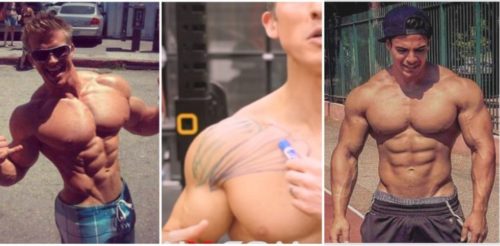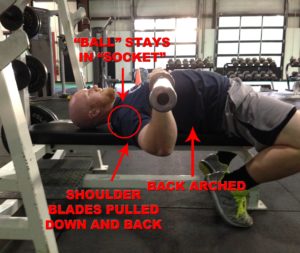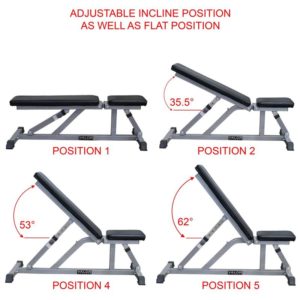If you’re a regular gym guy, you probably always take really good care of your chest days. This means that you maintain a full volume, solid frequency and techniques to boost your intensity as well as you can, such as dropsets or forced reps. Also, it means that you always want to try something new when it comes to chest gains because let’s face it – it’s never enough. However, simply because you put a lot of dedication into training your chest doesn’t mean that you’re actually getting the best possible results.
As a matter of fact, you may even be on the low end here, since these few chest training tips can take your gains to a whole new level. Let’s get into it.
1. Get Off The Damned Barbell Bench Press!
The bench press is a classic and of course, effective chest exercise, but that doesn’t mean you should waste away years of your life on it. Most people I know start off their workouts on the bench, with a barbell, and almost all of them hit a ceiling in their gains a long time ago. This means that when you do an exercise for so long, it stops being effective on your body – this concept is called diminishing returns and can be a real figurative pain in the neck. It can happen with pretty much every muscle and every exercise to train it, so make sure you switch up your routine often enough to prevent it. You can do this in a number of ways, the key point being that all of them will help you change your training routine just enough to make sure you continue to grow unimpeded.
The number one way to change the barbell bench press is to switch to dumbbells, of course. It will let you work on each of your body’s sides independently, which means you can train your pectorals in a far wider range of motion. Also, this way is much better for your shoulders than the barbell method. Also, you may want to do some flat benches in the second half of your workout. These exercises will help you keep your energy levels above average, as well as your weightlifting ability with any exercise.
This means that when you’re doing great on everything except your upper chest and you have incline presses for 230 pounds somewhere in your routine, moving them up and adding some weight will work out far better for you. The incline presses will give your body a muscle-building stimulus that will get the muscle fibers on your upper pectoral muscles growing again, as opposed to being stagnated with far lower levels of intensity. Know that doing flat benches later in your routine will mean that your strength levels will diminish significantly. You won’t be lifting the same amount of weight the same number of times, but this is also good because now you can switch to machine training and stop caring about weight balance.
2. Include More Bench Angles!
There is more to life than just doing incline, decline and flat bench exercises when chest day comes. The principle of diminishing returns happens with all of these, not just the flat bench ones, but that doesn’t have to stay that way. If you look at the adjustable bench and decline bench, you will see that you can use any one of them with dumbbells to do some flyes or presses, but also with the Smith-machine training. If you have a position you prefer to workout in while on a bench, you probably set your bench to it pretty much automatically before every workout, but you have to remember that there are a lot more positions that you can use.
Take for instance, the incline bench. You can put it on low, moderate or steep and every single setting will determine a different outcome in your chest muscle activation. This outcome is determined by the activity of your front deltoids and from the upper part of your pectorals. That being said, you can also switch up any possible style of doing decline bench presses by simply moving the bench up and down. If you want to get the best possible results, don’t constrain yourself to only three angles on the bench – do all of the angles on it, from lowest to highest and see what works the best!
3. Stop Overdoing Your Flyes!
Characteristic single-joint exercises such as flyes and cable crossovers are usually performed before finishing your training session, and when you do them you’re supposed to have your elbows slightly bent and locked into place. Because of this, your ability to lift weight will diminish and you will be able to lift less than with presses. However, some people don’t realize this and keep pumping on the weight on single-joint exercises, more weight than they could possibly lift. This causes their form to break down and while it doesn’t mean you are more prone to injury, it does mean that the muscular isolation will be reduced by doing something between flyes and presses.
You can observe a decent example of this in cable crossovers fairly easily. Just watch your elbows and draw your conclusions from there – if you have a little bend in your elbows while you’re doing the pulling, you’re doing it good, but if you aren’t locking that bend in and keeping it there while you do the set, it means that you’re closing up your elbows and then opening them when you get to the top of the movement, performing a pressing motion instead of a pulling one.
Presses are fine, but do them when you want to press weight, not when you want to pull cables. Your body needs to be stabilized, preferably on a bench, to be able to perform pushes that turn into presses. You need to finish up all of your pressing before you get to the cable crossovers anyway. Whatever you do, don’t put extra weight on single-joint movements because it seems flashier – you need to be able to do the exercise with the correct form, not by any means necessary! If you still can’t do it, get on a pec-deck machine and try to lock your elbows in a bend there. You’ll have an easier time because it keeps your arms in one place – the correct position. It should be impossible to stretch out your elbows when on a pec-deck.
4. Strengthen Your Front Deltoids!
When you want your pectorals to look really impressive, you also want your deltoids, more specifically their front heads, to look impressive as well. The deltoids are activated when you do your chest presses and all kinds of incline movements, so you need them to be strong. If they’re not, your chest gains will not be as impressive as they could be.
This means that you will need to consider changing your shoulder exercises to improve these muscles, and there are certain things you can always do. Think about doing some overhead shoulder presses that will focus on your frontal deltoids, but also maybe throw in some Arnold presses and barbell presses, where you could possible bring the bar in front of your face. You can also put some single-joint pressure on your frontal deltoids with single-joint exercises and putting a small rotation in them. You might even want to double up and put two rotations in there!
When you’re thinking about where to put your shoulder workouts in your workout routine, think about this – there should be at least two days between your chest and deltoid workouts. This is because you need the recovery period to make sure you aren’t overworking both muscle groups. However, if you have to train them on the same day, start by training the larger muscle group, which in this case would be the chest. If your frontal deltoids aren’t sufficiently strong though, put them first and you won’t regret it.
5. Strengthen Up Your Triceps!
Aside from your front deltoids, there are other muscles that might be limiting your chest growth, such as triceps, which are famed for their rate-limiting abilities if they aren’t sufficiently developed. This happens when you do multi-joint presses but extend your elbows every time. The triceps need to do the heavy lifting, don’t just let them flap there! If they aren’t strong enough, no matter what type of bench press you perform, there aren’t going to be any optimal results. If you want to strengthen them up, you will need to do some heavy lifting with your arms. This means performing multi-joint exercises such as close-grip bench presses, dips or machine dips for low to moderate reps and a lot of weight. You should also think about doing some triceps work over the course of the split, but not before chest day – you don’t want to burn out your arms before working on your chest. Especially stay away from arm exercises on chest day!
6. Strengthen Up Your Back!
The back also has an influence on your chest, and even though it might seem unusual, having a developed back is crucial for developing your chest. If your chest gets really buff but your back remains weak, your posture will decline because of it. Your body takes balance very seriously and because of the lack of it in this example, it will give you a slouched appearance by moving your shoulders forward, and nobody wants that. You need to watch your muscle balance to get jacked, so make sure to train smart and train hard on all muscle groups, even those that aren’t your first choice!
7. Do Your Presses Correctly!
If you go to a gym, you will most likely see someone pressing a bar until they reach full extension, but then lowering it halfway down instead of all the way. Also, there are a lot of people that stop the extension right before it is finished.
This is wrong and it is hurting your chest workout! When you limit the range of motion like that, you limit your growth as well because the chest isn’t getting worked on hard enough. If you’re cutting off the bottom part of the exercise, your strength levels for that part of the movement don’t change – they don’t grow, meaning you stay the same and there is no improvement!
After that, you start putting on more weight for the rest of the movement and still not training the neglected part because it can’t lift the new weight – because you never worked on it in the beginning! This is a magical circle that dooms chest progress and it means one simple thing – if you’re going to do partial reps, do them along with your full reps, not instead of them. If you want pumped, buff-looking muscles, this is a no-brainer.
8. Pull Your Shoulder Blades Back!
Keep a close watch on your shoulder blades while doing chest exercises, even if you aren’t used to it. Usually, people will just lower the bar and then push it back up without much thought, but you will need to keep a close eye on the shoulder blades as well, simply because it’s more effective that way. When you lower your arms down, you’re doing far more than the obvious – your body is retracting its shoulder blades when you’re doing the negative part of the repetition, meaning your chest will swell out because of the extra displacement. Your thoracic spine will experience an over-exaggeration in its curve but since you will be on a bench, you will be nice and stable. When you stretch like this, you will be able to put out more power through your pectoral muscles and stabilize and keep your shoulder safe in the meanwhile.
9. Pay Attention to Your Grip!
When you’re lifting your barbell up, think about changing your grip and moving your hands from the widest possible angle to the narrowest, with every angle in between. If your hands are close together, the exercise will affect your inner pectorals and with the longer range of motion your triceps get involved as well. When you put your hands on the wider part of the spectrum, you will activate the outer part of the pecs and the shoulders as well, but your range of motion will be reduced. I’m not saying to use these extremes – find a grip that suits you and hits all angles of your muscles hard, and switch it up every once in a while. When you do this, your chest doesn’t get used to one grip and grows.





Post your comment